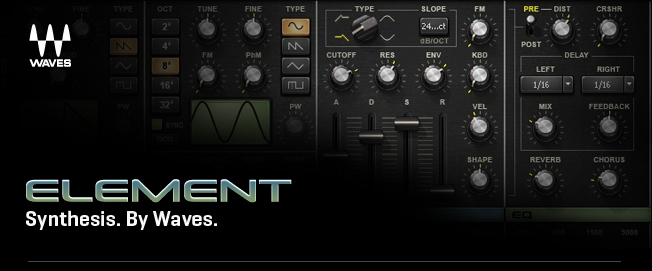You're currently on:

Introducing Element: The first ever synthesizer from Waves. Powered by Virtual Voltage™ technology, Element is an analog-style polyphonic instrument engineered to deliver the fat, gritty sound of the classics, with all the precision, flexibility and control of contemporary digital synths.
Element includes a vast array of convenient features and functions. Like integrated effects. A 16-step arpeggiator / sequencer. MIDI Learn for all controls. And a massive preset library, with total tweakability. Plus, all parameters are laid out right there in front of you, so when inspiration strikes, there’s no need to scroll through page after page to customize your sounds. Searing leads, booming basses, ethereal pads, electro-percussion, sequential motions, mind-blowing FX and lots more: Element does it all.
"This is gonna be awesome on the new Dream Theater album. Within no more than two minutes of playing Element, I knew that it was really great! The quality of the oscillators and filters, along with the depth of the modulation parameters, make it really top-class. I can’t wait to get in the recording studio and start using it!"
Jordan Rudess
Features
Powered by Virtual Voltage™ technology
Integrated chorus, delay, reverb, distortion and bit crusher effects
16-step arpeggiator / sequencer
Plugin and standalone components
Controls
Oscillators
OCT determines the pitch range.
TUNE determines the pitch.
FINE fine-tunes the pitch.
TYPE determines the waveform type.
PW determines the pulse width. (Pulse waves only)
VCO selects between virtual Voltage-Controlled Oscillation and virtual Digitally- Controlled Oscillation.
SINE MOD controls the modulation of OSC 1 using a sine oscillator. (OSC 1 only)
FM (Frequency Modulation) controls the amount by which the frequency of OSC 2 is modulated by OSC 1. (OSC 2 only)
PhM (Phase Modulation) controls the amount by which the phase of OSC 2 is modulated by OSC 1. (OSC 2 only)
SYNC synchronizes the triggering the OSC 2 waveform to the rate of OSC 1.
Additional Oscillators & Mix Section
SUB mixes in a triangle wave one octave below OSC 1.
NOISE mixes in white noise.
RING controls the ring modulation of OSC 1 and OSC 2.
OSC 1 / OSC 2 activate each oscillator.
MIX balances the mix between OSC 1 and OSC 2.
MONO toggles between monophonic and polyphonic modes.
RTRG controls envelope re-triggering.
UNISON activates a doubling effect which creates a richer sound.
PORT determines the glide time (portamento) between notes.
LEGATO determines whether glide will always occur, or only when the previous note is still held.
Voltage Controlled Filter
TYPE determines the filter type.
SLOPE toggles between two types of pole filters.
CUTOFF controls the VCF cutoff frequency.
RES controls the amount of filter resonance.
ENV determines the envelope’s cutoff modulation depth.
KBD controls keyboard tracking using C3 as its reference point.
FM controls the amount of frequency modulation on filter cutoff by OSC 1.
ADSR determines the filter’s envelope cutoff behavior after a note is triggered.
VEL sets the VCF cutoff in relation to the Note On velocity.
SHAPE determines the contour of the envelope time constants.
Voltage Controlled Amplifier
VCA envelope controls the note level from trigger to release.
VEL sets the envelope depth in relation to the Note On velocity.
SHAPE determines the contour of the envelope time constants.
PUNCH controls the dynamic transient enhancer.
Low Frequency Oscillators
TYPE controls the LFO waveform shape.
RATE controls the frequency of the free LFO.
TIME controls the rate of the synced LFO, locked to the project BPM.
LED displays pulsate at the same rate as the LFOs.
Envelope 3
VEL sets the envelope depth in relation to the Note On velocity.
SHAPE determines the contour of the envelope time constants.
Modulation Matrix
PHASE inverts the phase, per assignment.
SRC determines the modulation source.
DEST determines the destination of the modulation source.
MOD sets the amount by which the modulation source affects the destination.
Arpeggiator/Sequencer
MODE determines the operational mode.
OCT determines the range, in octaves, of the arpeggiator.
TIME (drop-down) activates the host BPM sync function, and sets the rate using note values.
RATE sets the arpeggiator rate when TIME is set to Free.
GATE determines the length of each sequencer step as a percentage of its note length.
STEPS determines the number of steps in the current sequence.
SWING pushes even-numbered notes/steps toward the next odd-numbered note/step, to create a shuffle/swing feel.
Effects
DIST controls the amount of distortion effect.
PRE/POST is a toggle control which determines the placement of the distortion effect in the signal path, either pre-VCF or post-VCF.
CRSHR is a distortion-like effect which simulates a reduction in the bit-depth and resolution of the sound.
DELAY is a stereo delay allows separate delay times for left and right channels, using note values.
LEFT sets the delay time for the left channel.
RIGHT sets the delay time for the right channel.
MIX determines the amount of delay effect in the mix.
FEEDBACK determines the amount of gain fed back to the delay input.
REVERB controls both the amount and size of the virtual plate reverb sound.
CHORUS determines the amount of chorus modulation.
EQ
HiPASS controls the high pass filter frequency.
LoPASS controls the low pass filter frequency.
100 controls equalization at 100 Hz.
600 controls equalization at 600 Hz.
1500 controls equalization at 1500 Hz.
9000 controls equalization at 9000 Hz.
Global and Out Sections
TEMPO displays the current tempo.
SOURCE determines the clock source.
VOICES determines the number of voices which may be played simultaneously.
HD activates High Definition mode, which extends the digital resolution, resulting in enhanced depth and greater high-end definition.
GAIN sets Element’s overall output volume, after all generators and processors.
METER displays Element’s overall output energy.
9000 controls equalization at 9000 Hz.







